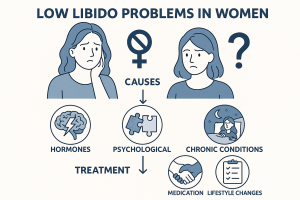Low Libido and Arousal Problems in Women: How Somatic Yoni Therapy Can Help

Low sexual desire is not just a physical issue — it’s emotional, neurological, relational, and deeply embodied. For millions of women, the phrase “I’m just not in the mood” masks years of quiet suffering, confusion, shame, and fear. This article provides a professional, research-informed exploration of low libido in women and introduces somatic yoni therapy as a clinically grounded, trauma-aware method of restoring arousal and body trust.
What Is Low Libido?
Low libido, or Hypoactive Sexual Desire Disorder (HSDD), is defined by a persistent or recurring lack of sexual interest that causes personal or interpersonal distress. It’s one of the most common sexual health complaints among women — affecting up to 40% at some point in life (Laumann et al., 1999; Shifren et al., 2008).
Common Symptoms
- No desire for sex, even with a loving partner
- Avoidance of physical closeness or initiation
- Numbness or disconnection in the genital area
- Feeling pressured or indifferent during intimacy
- Mental shutdown when touched
Why It Matters
- Emotional impact: Women often internalize their struggle, feeling broken, inadequate, or guilty.
- Relational toll: Fear of losing a partner or damaging the relationship due to mismatched desire.
- Medical neglect: Many women are misdiagnosed or dismissed as hormonal or “just tired.”
The Behavior Pattern of Women With Low Desire
- Timing: Most women Google this issue alone, late at night.
- Silence: Rarely brought up with doctors or partners.
- Self-blame: Often believed to be a personal flaw rather than a solvable condition.
- High-functioning outside the bedroom: Career, motherhood, and social life may appear unaffected.
Root Causes of Low Libido
1. Nervous System Dysregulation
Chronic stress, anxiety, or unresolved trauma push the nervous system into sympathetic overdrive (fight-or-flight) or dorsal vagal shutdown (freeze). Neither state supports arousal.
2. Pelvic Tension and Numbness
Long-term suppression of sexual expression or trauma can lead to muscular guarding in the pelvic floor. This causes numbness, pain, or dissociation from the yoni (vulva and vagina).
3. Hormonal Shifts
While often overemphasized, changes during postpartum, menopause, or due to birth control can affect libido — but rarely explain the whole picture.
4. Relational Disconnection
Unspoken resentment, unbalanced emotional labor, or lack of emotional safety reduces desire, even in otherwise “functional” relationships.
5. Cultural Conditioning
Sex-negative messages, shame around pleasure, and lack of accurate sexual education condition women to disconnect from their erotic selves.
What Is Somatic Yoni Therapy?
Somatic yoni therapy is a body-based, client-led approach to healing female sexual disconnection. It blends trauma-informed bodywork, therapeutic touch, breathwork, and emotional processing — focused entirely on restoring the woman’s connection to her own body.
Core Principles
- Consent and agency: The client leads every step — nothing is done without verbal and embodied consent.
- Safety and presence: The practitioner is trained to co-regulate and hold space without goal orientation.
- Body-first healing: Words are optional; the body is the storyteller and the site of transformation.
What Happens in a Session?
- Grounding and breathwork to regulate the nervous system.
- Verbal check-in to set intentions and boundaries.
- External pelvic massage (vulva, thighs, hips, sacrum).
- Optional internal work with gloved fingers — gently releasing muscular tension and mapping sensation.
- Emotional expression, tears, or trembling may arise as trauma leaves the body.
How Somatic Yoni Therapy Helps With Low Libido
1. Restores Sensation
Gentle touch, breath, and presence reawaken nerve endings and bring blood flow back to underused or armored tissues.
2. Releases Tension and Trauma
Chronic tension in the pelvic floor is released layer by layer — physically and emotionally.
3. Rebuilds Trust With the Body
Many women fear their body is broken. Somatic work rebuilds communication and trust between brain and genitals.
4. Reclaims Pleasure Without Performance
The goal isn’t orgasm. It’s presence. Many clients rediscover spontaneous desire once the pressure is removed.
5. Changes Relationship With Touch
By receiving slow, non-demanding touch, women relearn what safe, supportive, pleasurable contact feels like — outside of performance or expectation.
Professional Ethics and Safety
Somatic yoni therapy must be trauma-informed, ethical, and practiced by a certified professional. Sessions should never feel invasive, sexualized, or rushed. Look for practitioners trained in:
- Somatic Experiencing (SE)
- Sexological Bodywork
- Holistic Pelvic Care
- Internal Family Systems (IFS) or trauma integration
Always interview your practitioner beforehand, and trust your instincts.
Is It Right for You?
Consider somatic yoni therapy if you:
- Feel numb or shut down sexually
- Have tried talk therapy without results
- Want to explore without medicalization or pressure
- Are curious but scared — that’s a valid place to begin
It’s not about being “fixed.” It’s about coming home to yourself.
Final Thoughts
Low libido is not a flaw — it’s a signal. Arousal doesn’t start in the genitals; it begins with safety, presence, and embodied connection. Somatic yoni therapy offers women a gentle, science-supported path to reawakening — not just sexually, but emotionally and spiritually.
No more silent suffering. No more guilt. Just one step toward feeling again.
If you’re quietly searching for answers — this is your sign to begin.
Sources available upon request. This article is intended for educational purposes and does not replace professional medical or psychological advice.

 Tags:
Tags: